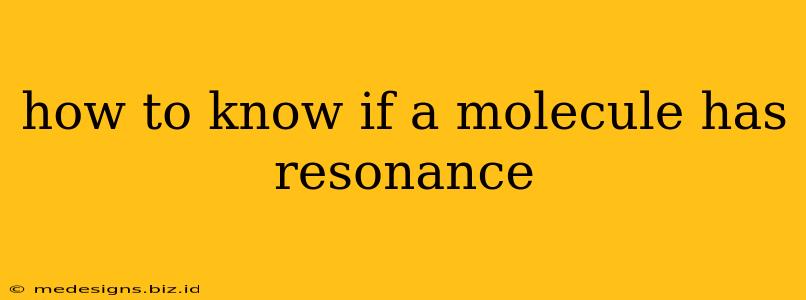Resonance is a crucial concept in chemistry, describing the delocalization of electrons within a molecule. Understanding resonance structures is vital for predicting molecular properties like stability and reactivity. But how do you know if a molecule exhibits resonance? This guide provides a clear and comprehensive approach to identifying resonance structures.
What is Resonance?
Before we delve into identifying resonance, let's briefly recap the concept. Resonance occurs when a molecule can be represented by two or more Lewis structures that differ only in the placement of electrons (typically π electrons and lone pairs). These individual structures are called resonance structures or contributing structures, and they are not different molecules; rather, they represent different depictions of the same molecule. The actual molecule is a hybrid, a blend of all contributing resonance structures, often more stable than any single structure.
Key Indicators of Resonance:
Several clues indicate the presence of resonance within a molecule. Look for these characteristics:
1. Conjugated π Systems:
The most common sign of resonance is the presence of a conjugated π system. This means that there's an alternating sequence of single and double bonds, or a combination of double bonds and lone pairs on atoms adjacent to double bonds. These systems allow for the delocalization of π electrons across multiple atoms.
- Example: Benzene (C6H6) is a classic example. Its six carbon atoms form a ring with alternating single and double bonds. The π electrons are delocalized across the entire ring, leading to significant resonance stabilization.
2. Lone Pairs Adjacent to Double Bonds:
Lone pairs of electrons on an atom directly bonded to a double bond can participate in resonance. These lone pairs can delocalize into the π system, creating additional resonance structures.
- Example: Nitrate ion (NO3-) has a nitrogen atom with a lone pair adjacent to two double bonds. This allows for resonance, stabilizing the ion.
3. Allylic Systems:
Allylic systems, where a double bond is adjacent to a carbon with a substituent (like a halogen or alkyl group), often exhibit resonance. The electrons in the double bond can delocalize towards the adjacent carbon.
- Example: Allyl cation (CH2=CH-CH2+) displays resonance; the positive charge is delocalized across the two terminal carbons.
Identifying Resonance Structures:
To determine the resonance structures for a given molecule, follow these steps:
-
Draw the Lewis Structure: Begin by drawing a valid Lewis structure for the molecule. Ensure that all atoms have a full octet (except for hydrogen, which has a duet).
-
Identify Conjugated Systems & Lone Pairs: Look for conjugated π systems or lone pairs adjacent to multiple bonds, as previously discussed.
-
Move Electrons: Systematically move electrons (π electrons and/or lone pairs) to create alternative Lewis structures. Remember, only the position of electrons changes; the positions of atoms remain fixed.
-
Check Formal Charges: Assign formal charges to each atom in each resonance structure. Structures with minimized formal charges are generally more stable and contribute more significantly to the resonance hybrid.
-
Draw the Resonance Hybrid: The resonance hybrid represents the actual molecule. It's a representation showing the delocalized electrons as spread out across the conjugated system. Often, bond lengths in the resonance hybrid are intermediate between single and double bonds.
Examples:
Let's illustrate with some examples:
Example 1: Acetate Ion (CH3COO-)
The acetate ion possesses resonance due to the presence of a lone pair on one of the oxygen atoms adjacent to a double bond. Two resonance structures can be drawn, with the negative charge delocalized between the two oxygen atoms.
Example 2: Ozone (O3)
Ozone displays resonance due to the central oxygen atom's bonding. Two resonance structures can be drawn, with each terminal oxygen having a formal charge.
Conclusion:
Determining whether a molecule exhibits resonance is a crucial skill for any chemist. By recognizing the key indicators of conjugated systems and lone pairs adjacent to double bonds, and carefully following the steps for drawing and evaluating resonance structures, you can confidently identify and understand the resonance phenomenon and its impact on molecular properties. Remember to always consider formal charges and the stability of the contributing structures when assessing the overall resonance hybrid.
